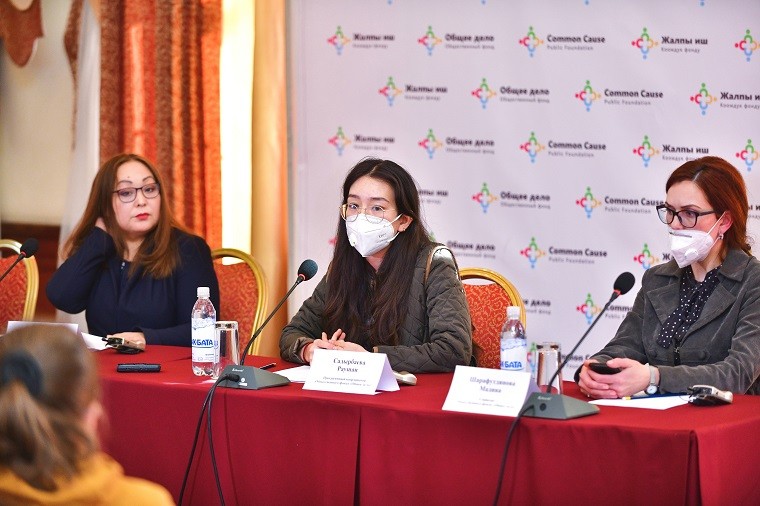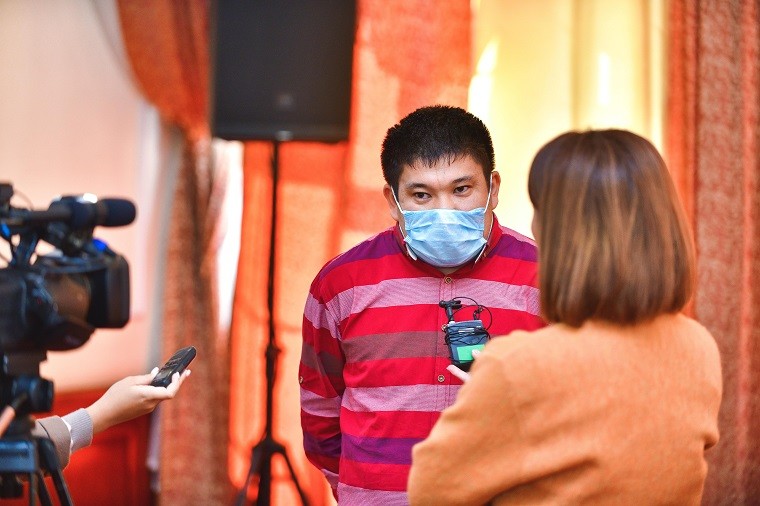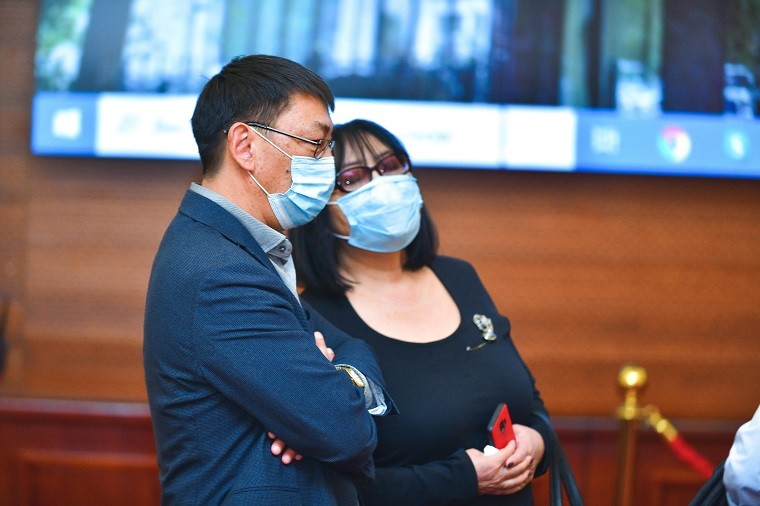Preliminary Statement on Election day
October 4, 7:00 until October 5, 8:00
Bishkek, October 5, 2020 – 13:30 – Public Foundation “Common Cause” (the Foundation) deployed 300 stationary observers, 58 mobile teams and eight regional lawyers across the country, to observe the opening procedures, voting, counting and tabulation of results. For stationary observation at polling stations, the Foundation implemented a Sample Based Observation (SBO) methodology, an advanced election monitoring technique enabling it to draw conclusions about selected election day processes representative of the entire country.
Opening, voting, closing and tabulation procedures were largely carried out according to the law. Minor procedural violations were observed at a small proportion of polling stations, while 23 violations of a serious nature were reported. Observations by the mobile team carried out at additional 452 polling stations showed that the environment around polling stations was generally calm. However, tense situations were observed at 28 polling stations visited. Although not illegal, different political parties organized transportation of voters across the country. Illegal campaigning took place throughout the election day. Common Cause observers monitoring the work of Territorial Election Commissions did not report major violations as of 08:00 on 5 October 2020 .
The 2020 turnout as projected by Common Cause was 56,2 percent with a Margin of Error of 1,7 percent. The CEC reported at 22:30 on October 4 that the nationwide turnout was 56,2 percent. It represents an increase of 18,3 percent compared to the 2015 parliamentary election (37,9 percent).
As of now, Common Cause has submitted 43 written submissions to PECs, related to minor procedural violations, whilst 8 complaints were submitted to TECs and two to the police.
Isolated reports of violence and alleged reports of violations such as vote buying, Form 2 manipulations, misuse of administrative resources and intimidation in the pre-election period has likely affected the election day processes the extent of which is difficult to measure. We call upon all responsible institutions to investigate all reported violations and sanction all illegal acts.
The results of the Sample Based Observation related to election day monitoring are as follows:
Opening of Polling Stations
Observers reported that the election day commenced peacefully with few minor violations observed. All “Common Cause” observers were granted access to observe the election process at designated polling stations.
Opening procedures were largely conducted according to the law. A vast majority of polling stations (83 percent) held preparatory meetings for opening by 07:30. 28 percent of polling stations opened for voting before 8:00, 71 percent at 8:00, and less than one percent opened slightly later. Observers reported that 68 percent of polling stations were fully accessible for people with limited mobility, and an additional 20 percent were partially accessible.
At most polling stations (91 percent), the PECs fully followed procedures related to COVID-19 during the preparation for opening. Observers reported that PECs partially followed these procedures at an additional 8 percent of polling stations. At 96 percent of polling stations, specific roles were assigned among poll workers by drawing lots, according to the law. Ballot boxes were shown to be empty at almost all (99,7 percent) observed polling stations, and were properly sealed at 99 percent of them. A signed checklist was dropped in the ballot box at 98 percent of polling stations, and a manual count of received ballots took place at 93 percent of polling stations.
Voting
Observers reported that the voting was generally peaceful with a small number of procedural violations and a few isolated serious violations. A vast majority of “Common Cause” observers enjoyed full observation rights. However, observation was hindered at 4 percent of polling stations due to improper operations of PEC members.
Voters followed COVID-19 recommendations at 96 percent of polling stations and 87% of PEC’s implemented COVID-19 recommendations. Due to COVID-19 procedures, observers reported queues during voting at 67 percent of polling stations.
In 10 percent of polling stations, there were more than 10 people who could not vote because their names were not on the voters’ list. Smaller number of people had similar problems in 61 percent of polling stations.
Voters were generally properly identified. There were no polling stations where observers reported that 10 or more voters had been permitted to vote without proper identification.
No problems related to technical equipment were observed at 91 percent of polling stations. However, due to such failures, a small number of voters (five or less per polling station) were not able to vote at 8 percent of polling stations observed. Electronic voting machines were replaced with traditional ballot boxes at 7 percent of polling stations.
In almost all (99 percent) polling stations there were no cases where someone was allowed to vote without being on the voters’ list.
There was no intimidation and/or pressure towards voters observed at 98 percent of polling stations.
Unauthorized persons were observed at 4 percent of polling stations, whilst bribery of voters was observed at 3 percent. Campaigning within polling stations has been observed at 3 percent of polling stations.
Closing of Polling Stations and Tabulation of Votes
Observers reported that the closing process was generally peaceful with a small number of procedural violations and a few isolated serious violations. All observers were able to observe the counting process in an unimpeded manner.
Almost all polling stations (94 percent) closed on time, whilst 5 percent closed before 20:00 and 1 percent closed after the official closing time. The election law allows those inside the polling station at 20:00 to cast their ballots, while people outside the polling station are not allowed to vote. There were people in queues inside 5 percent of polling stations at closing time. At 8 percent of polling stations, there were voters outside the polling station premises at 20:00 who were unable to vote.
The 2020 turnout as projected by the Common Cause 56,2 % with a Margin of Error of 1,7 %.
Most (90 percent) of PECs complied with COVID-19 recommendations during counting, whilst 10 percent had problems complying.
The unused ballots were cancelled in accordance with the law at 98 percent of polling stations. Mobile ballot boxes were opened according to the law at 96 percent of polling stations.
Ballot counting was carried out in an open and transparent manner. The manual ballot count was conducted openly and publicly at 99 percent of polling stations. Only at 1 percent of polling stations did the PEC not consider existing complaints before the protocol was signed.
The protocols were completed at all observed polling stations. The observers were able to get the number of ballots issued to voters at 96 percent of polling stations and copies of reports from identification machines and the ballot box at 99 percent, and a certified copy of the hand counted protocol on voting results at 96 percent of polling stations .
Observation Findings from Mobile Teams
58 mobile teams visited 452 different PECs to observe the situation around polling stations. Mobile teams have described the situation around 407 polling stations as calm while tense situations were reported from 28 polling stations. At 17 polling stations, the situation was hard to assess from the mobile teams perspective.
Long queues were observed at almost ⅓ of polling stations due to compliance with COVID-19 mitigation regulations. The presence of people of strong physique was observed at 19 PECs but their operations could not be assessed as illegal during the mobile teams visits. Bussing of voters was observed at 29 PECs and illegal campaigning was observed at 26 polling stations.
Observation Findings from Territorial Election Commissions
Common Cause observers monitored all 54 Territorial Election Commissions (TECs) following the closing of polling stations in an unimpeded manner.
All observers were able to get copies of handover acts of first voting results from PECs to TECs in 50 of the 54 commissions (92 percent). Voting results protocols from PECs were preliminarily reviewed to tabulate results within TEC territory at 46 out of 52 TECs (85 %).
One incident was recorded at the Karakol city TEC in the Issyk-Kul region, where TEC members rewrote data from the accepted PEC protocol written by pen. A respective complaint was filed at the TEC.
Violations and Complaints on Election Day
Common Cause observers reported several serious violations and many procedural irregularities throughout the opening, voting, and counting processes. Members of the election observation mission have launched respective legal proceedings. As of 08:00 on October 5, “Common Cause” has filed 43 written submissions on incidents to the PECs; six complaints to the TECs; and two reports to the police, including related to:
- Voting for another person: 5304 Osh;
- Ballot stuffing: 1003 Bishkek;
- Illegal Campaigning: 5264 Osh;
- Secrecy of ballot violated: 2336 JalalAbad; 5556 Osh; 1003 Bishkek; 8160 Kyzyl-Kiy; 7187 Chui.
A List of Serious Violations Observed
23 serious violations have been reported and verified on Election day, including:
- Vote buying: 1126 Bishkek;
- Voting for another person: 5304 Osh; 1003 Bishkek; 8160 Batken; 5378 Osh;
- Secrecy of ballot violated: 2336 JalalAbad; 5556 Osh; 1003 Bishkek; 8160 Batken; 7187 Chui; 5556 Osh; 3154 Issyk-Kul; 5532 Osh; 2009 Jalal-Abad;
- Campaigning on Election Day: 5264 Osh; 8075 Batken; 5272 Osh; 5902 Osh; 6053 Talas;
- Voters not finding themselves on voters list: 4103 Naryn; 7351 Chui;
- Voters not being able to vote: 5125 Osh;
- Voters allowed to vote without identification: 7302 Chui;
- Observers not allowed to observe or hindered to observe: 1003 Bishkek; 5134 Osh.
A List of Minor Procedural Incidents Observed
- Preparatory meeting of PEC did not take place: 1208 Bishkek, 1321 Bishkek; 1205 Bishkek.
- Late meeting of the PEC before the opening: 8152 Batken; 1208 Bishkek; 8065 Batken; 8105 Batken;
- Ballot box problems: 8049 Batken; 8065 Batken; 2132 Jalal – Abad; 1208 Bishkek/Bishkek; 4088 Naryn; 7243 Chui; 4030 Naryn; 7079 Chui; 4068 Naryn; 2646 JalalAbad; 8105 Batken; 1126 Bishkek; 2236 Jalal-Abad;
- Ballot box not sealed: 5573 Osh;
- No control sheet printed: 2132 JalalAbad; 1208 Bishkek; 9049 Batken;
- No drawing of lots: 1305 Bishkek; 1321 Bishkek; 8120 Batken; 5370 Osh; 5142 Osh; 1205 Bishkek;
- No manual count of ballots took place: 1321 Bishkek; 1208 Bishkek; 7378 Chui; 7211 Chui; 7260 Chui; 1205 Bishkek;
- Control sheet not issued: 2132 JalalAbad;
- Late opening of polling stations: 8152 Batken;
- Malfunctioning of voter identification equipment: 1150 Bishkek, 1150 Bishkek;
- Protocol filled out with violations: 7138 Chui;
- Violations during vote count: 1216 Bishkek (unused ballots were not destroyed);
- Presence of unauthorized people: 5573 Osh, 2230 JalalAbad.
Common Cause will continue monitoring the complaints deliberation processes at higher level election administration bodies and courts, as applicable.
Pre-election Period
Due to the 5-day ban on issuing reports related to elections before the election day, Common Cause would like to highlight its findings related to the pre-election period. Isolated reports of violence and alleged reports of violations such as vote buying, Form 2 manipulations, misuse of administrative resources and intimidation in the pre-election period has likely affected the election day processes the extent of which is difficult to measure. We call upon all responsible institutions to investigate all reported violations and sanction all illegal acts.
During six weeks of observation, LTOs submitted 348 reports covering long-term observation in all rayons of the country since August 24, 2020.
The occurrence of violence in the pre-election campaign is inexcusable in democratic elections. Unfortunately, instances of campaign violence were reported in Osh, Uzgen, Aravan, Naryn, and Chui, and unfortunately, one party activist has died.
There were 112 reports about vote buying. Among most commonly referenced were Mekenim Kyrgyzstan (90 reports), Birimdik (75 reports), Kyrgyzstan (70 reports). However, the vote buying was impossible to verify, but Common Cause has called upon authorities to investigate this issue as soon as possible.
LTOs noted that public servants and municipal employees were campaigning for Birimdik (65 cases Mekenim Kyrgyzstan (24 cases), Kyrgyzstan (6 cases) and Zamandash (4 cases). In 2 cases, LTOs reported the misuse of administrative resources in favor of Birimdik political party.
Campaign materials posted in undesignated places were mentioned in 31 reports. Destruction of campaign materials took place in 3 cases, and these relate to campaign materials of Mekenchil and Mekenim Kyrgyzstan political parties. According to 25 reports, the disinformation was spread about Mekenim Kyrgyzstan and Birimdik parties. In 8 cases, Mekenchil, Butun Kyrgyzstan and Respublica were denied access to buildings for holding meetings.
The Form -2 issue raised concerns and undermined the transparency of the election process. The number of applications for the Form-2 mechanism as of September was 496. 239. This unusually high number was lowered by the Central Election Commission which published the number of registered Form 2 voters – 441 010 on election day only. This has somewhat undermined the overall transparency of the electoral process. This number still represents 12,51 percent of the entire electorate. Alleged manipulations of the Form-2 mechanism by political parties are still on-going and final conclusions on the issue will only be possible in the post-election period.
Thank you
Common Cause would like to thank all election administration bodies for their cooperation as well as its observers who observe during the pre-election period and on election day across the country.
The Common Cause will continue to monitor the post-election period and issue periodic reports as necessary. The final report on electoral observation will be issued in 30 days.












